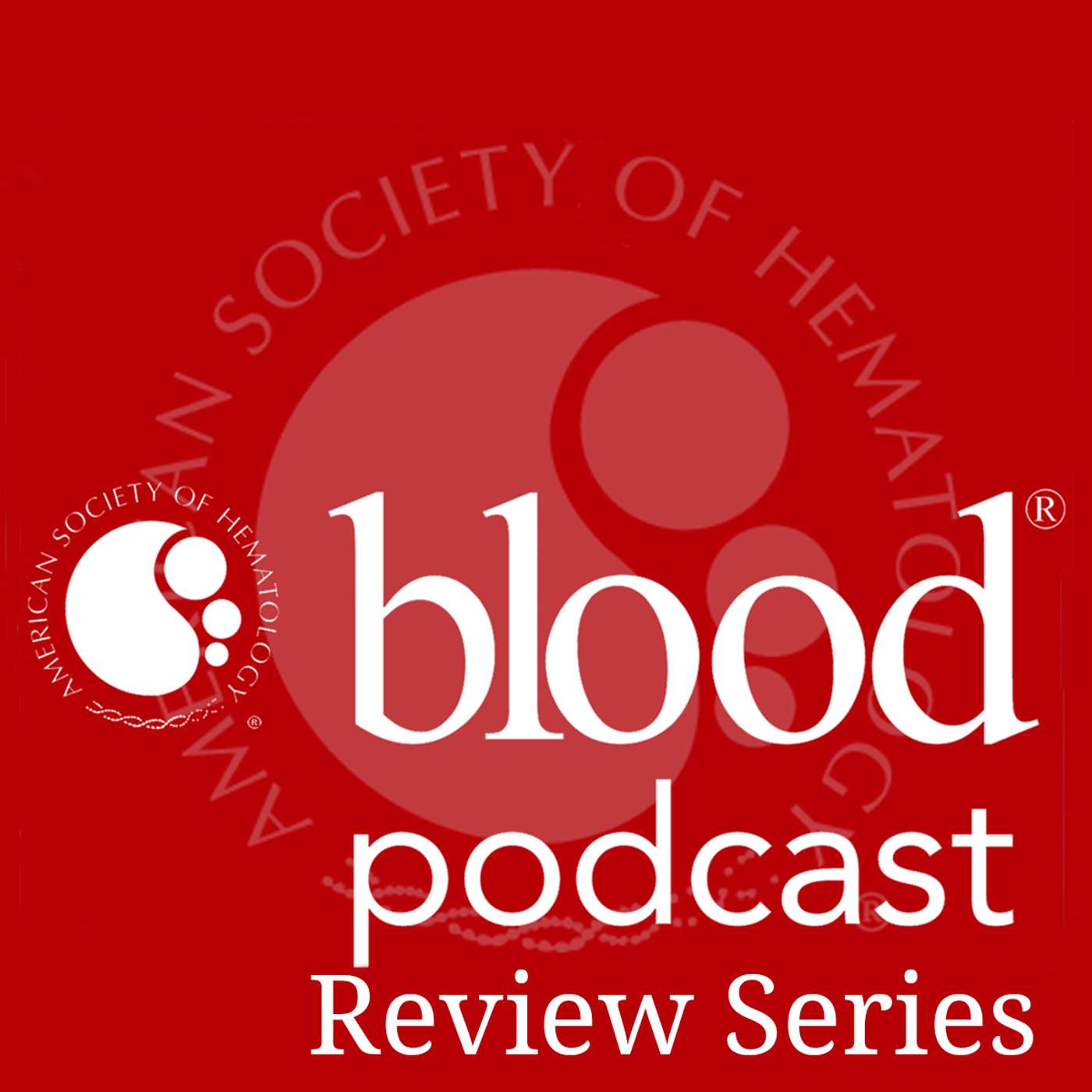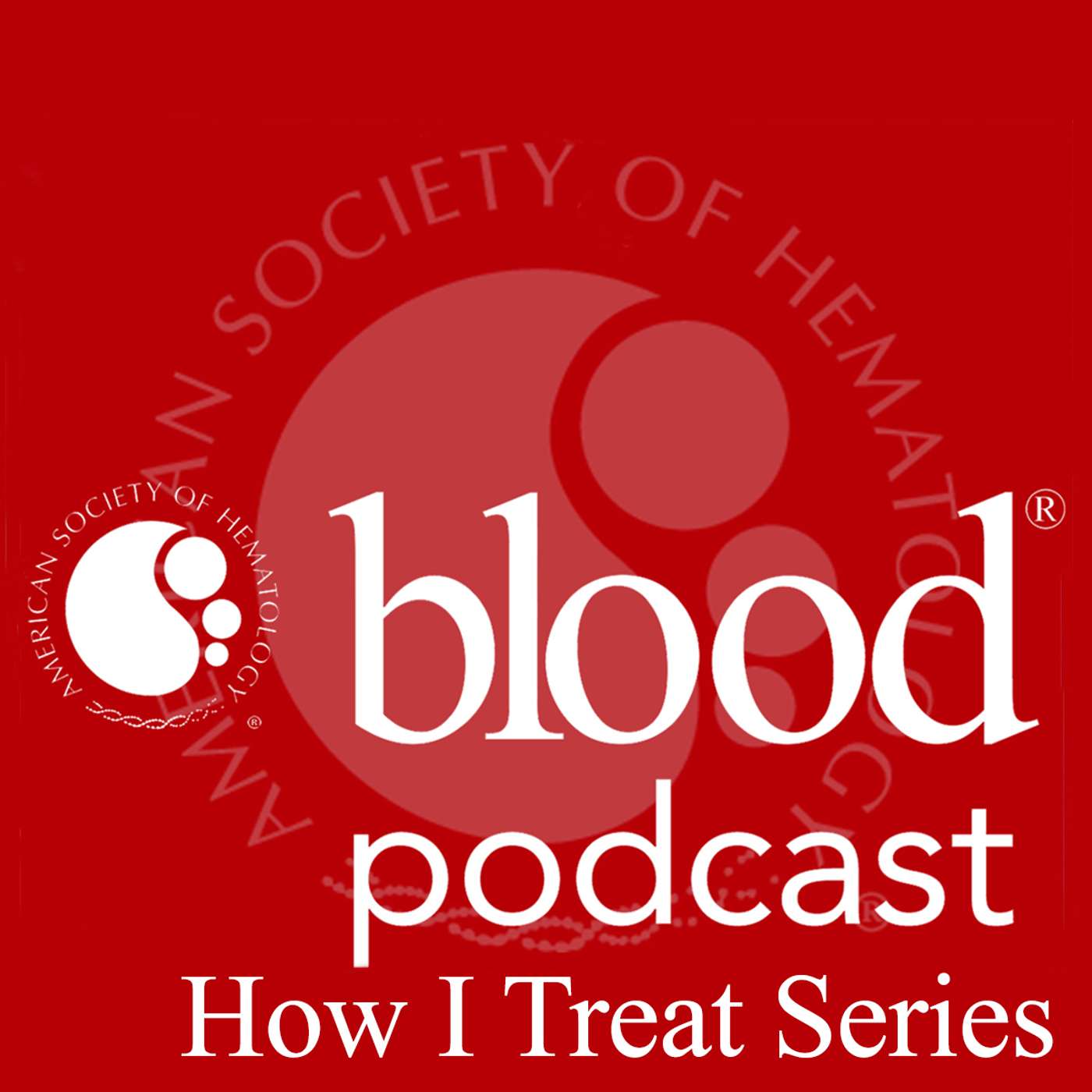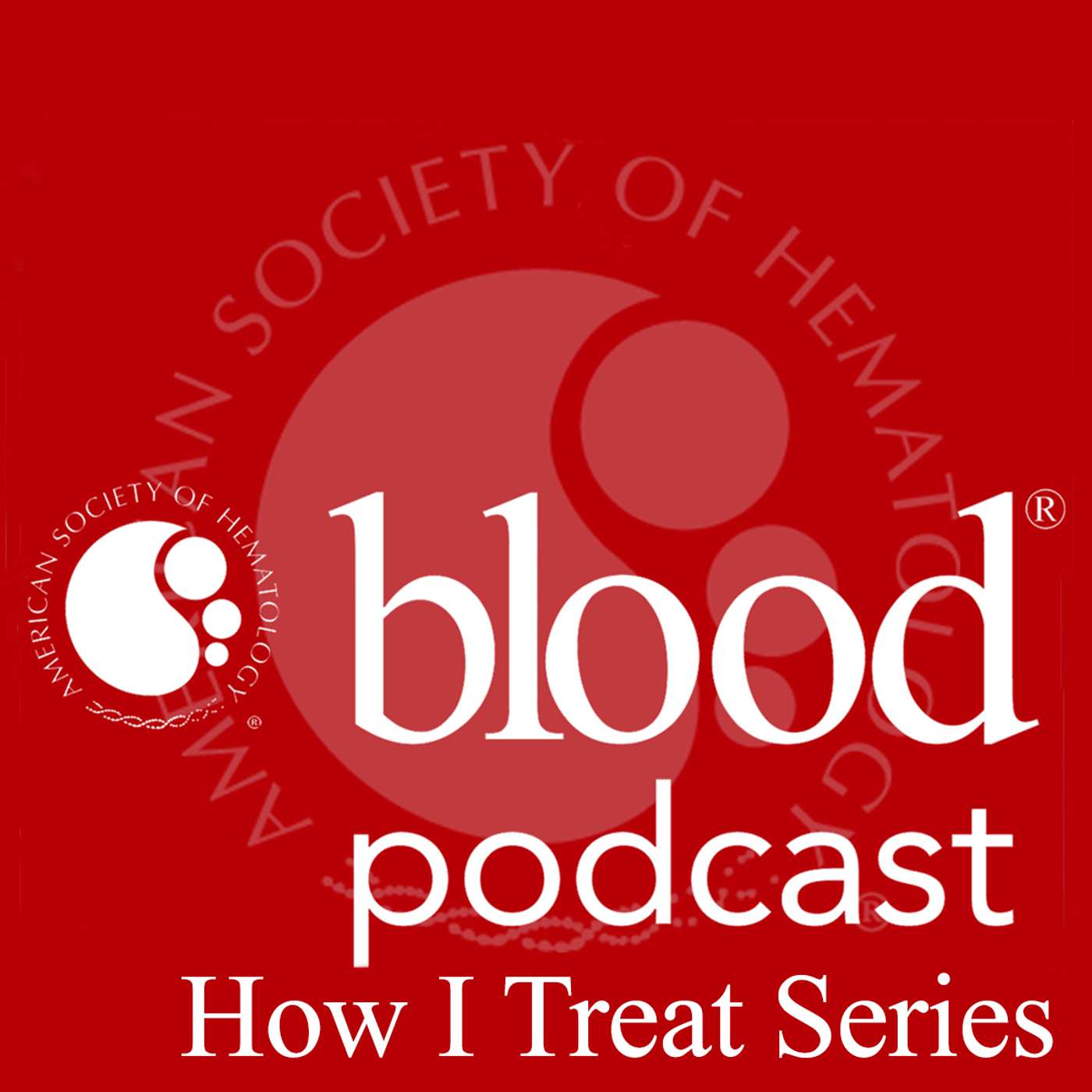Discover Blood Podcast
Blood Podcast

Blood Podcast
Author: American Society of Hematology
Subscribed: 389Played: 12,169Subscribe
Share
© 2025 American Society of Hematology
Description
The Blood Podcast summarizes content recently published in Blood, the most cited peer-reviewed publication in the field of hematology.
354 Episodes
Reverse
In this week's episode, Blood editor Dr. Laurie Sehn interviews authors Drs. Lorenzo Falchi and Robert Levy on their latest papers published in Blood Journal. Dr. Falchi discusses his work on an open-label, multicenter phase 1b/2 study evaluating fixed-duration epcoritamab with rituximab and lenalidomide in 108 patients with relapsed or refractory follicular lymphoma. Dr. Levy shares his work on demonstrating that in vivo expansion of Tregs in recipients prior to transplant is possible by activating TNFRSF25 (also known as death receptor 3) in combination with low-dose interleukin-2 in preclinical models. Both papers showed impressive and promising results for the treatment of lymphoma and GVHD.Featured ArticlesFixed-Duration Epcoritamab Plus R2 Drives Favorable Outcomes in Relapsed or Refractory Follicular LymphomaPre-transplant targeting of TNFRSF25 and CD25 stimulates recipient Tregs in target tissues ameliorating GVHD post-HSCT
In this week's episode, Blood editor Dr. Laura Michaelis interviews authors Drs. Terri Parker and Peter Lenting on their latest papers published in Blood Journal. Dr. Lenting discusses his work on introducing a new therapeutic approach to von Willebrand disease with the development of a novel bispecific antibody (KB-V13A12) that links endogenous mouse VWF to albumin, extending VWF half-life twofold with cessation of provoked bleeding. Dr Parker shares the results of a 43-patient phase 2 study that evaluates the single agent isatuximab, a CD38 monoclonal antibody, in patients with relapsed/refractory AL amyloidosis. With a hematological response rate of 77%, organ response rates between 50 and 57%, and an excellent safety profile, the current study lays the foundation for future use of isatuximab across treatment settings and combination strategies.Featured ArticlesIsatuximab for Relapsed and/or Refractory AL Amyloidosis: Results of a Prospective Phase 2 Trial (SWOG S1702)A bispecific nanobody for the treatment of von Willebrand disease type 1
In this week's episode, associate editor Dr. James Griffin interviews researchers Dr. John Semple and Dr. Othman Al-Sawaf on their groundbreaking studies on transfusion-related acute lung injury and chronic lymphocytic leukemia treatment. Dr. Semple explored how mitochondrial DNA could act as a first hit in lung injury, while Dr. Al-Sawaf revealed that patient fitness may not significantly impact the efficacy of targeted CLL treatments. Both studies challenge existing medical assumptions and suggest new approaches to understanding disease mechanisms and treatment responses.Featured ArticlesThe impact of fitness and dose intensity on clinical outcomes with venetoclax-obinutuzumab in CLLMitochondrial DNA via recipient TLR9 acts as a potent first-hit in murine transfusion-related acute lung injury (TRALI)
In this week's episode, Blood editor Dr. Laura Michaelis interviews author Dr. Taylor Brooks on his latest paper published in volume 146 issue 18 of Blood Journal. The conversation discusses outcomes of bispecific antibodies (epcoritamab or glofitamab) in treating aggressive B-cell lymphoma in a study with 245 patients. Findings show a tentative way forward in treatment for patients with relapsed or refractory (R/R) diffuse large B-cell lymphoma (DLBCL).Featured Article:Real-world outcomes of patients with aggressive B-cell lymphoma treated with epcoritamab or glofitamab
In this Review Series episode, Associate Editor Dr. Philippe Armand speaks with multiple authors about what it might look like to improve treatments follicular lymphoma, a disease that has been put on the backburner of innovation due to its generally treatable nature. Dr. Armand discusses "Treatment of relapsed and refractory follicular lymphoma: which treatment for which patient for which line of therapy?" with author Dr. Carla Casulo, "The future of follicular lymphoma management: strategies on the horizon” with author Dr. Sarah C. Rutherford, and "An updated understanding of follicular lymphoma transformation” with Dr. Erin M. Parry.Find the whole review series on follicular lymphoma in volume 146 issue 15 of Blood Journal.
In this week's episode of the Blood Podcast, Associate Editor Dr. James Griffin interviews Drs. Binod Dhakal and Ruben Bierings about their respective papers published in this week's issue of Blood. Dr. Dhakal presents his study on using talquetamab, a bispecific antibody, as a bridging therapy before BCMA-targeted CAR T-cell therapy in multiple myeloma patients, showing promising results with high response rates and manageable toxicities. Next, Dr. Bierings identified patients with genetic variants in the guanine exchange factor MAP kinase–activating death domain (MADD) that impair VWF secretion from endothelial cells and possibly cause VWD type 1. Featured ArticlesA novel cause of type 1 von Willebrand disease: impaired exocytosis of Weibel-Palade bodies due to biallelic MADD variantsSophie Hordijk, Stijn A. Groten, Petra E. Bürgisser, Sebastiaan N. J. Laan, Georg Christoph Korenke, Tomáš Honzík, Diane Beysen, Frank W. G. Leebeek, Paul A. Skehel, Maartje van den Biggelaar, Tom Carter, Ruben BieringsSequential targeting in multiple myeloma: talquetamab, a GPRC5D bispecific antibody, as a bridge to BCMA CAR-T therapyBinod Dhakal, Othman S. Akhtar, David Fandrei, Alexandria Jensen, Rahul Banerjee, Darren Pan, Shambavi Richard, Reed Friend, Matthew Rees, Patrick Costello, Mariola Vazquez Martinez, Oren Pasvolsky, Charlotte Wagner, James A. Davis, Omar Castaneda Puglianini, Ran Reshef, Aimaz Afrough, Danai Dima, Manisha Bhutani, Omar Nadeem, Ricardo Parrondo, Ciara Freeman, Lekha Mikkilineni, Shahzad Raza, Larry D. Anderson Jr, Prashant Kapoor, Hitomi Hosoya, Saurabh Chhabra, Ariel Grajales-Cruz, Mahmoud Gaballa, Shonali Midha, Melissa Alsina, Douglas Sborov, Krina Patel, Yi Lin, Christopher Ferreri, Nico Gagelmann, Anupama Kumar, Doris Hansen, Andrew Cowan, Luciano J. Costa, Maximilian Merz, Surbhi Sidana
In this Spotlight series episode on Acute Myeloid Leukemia, Blood Editor, Dr. Selina Luger interviews Drs. Laura Michaelis and Alexander Perl on their paper in the series titled “The fit older adult with acute myeloid leukemia: clinical challenges to providing evidence-based frontline treatment”. The conversation explores challenges in treating AML across different patient populations. They also focus on treatment approaches for fit older adults with AML, highlighting the need for less toxic therapies and ongoing randomized trials to better understand treatment efficacy. See the full spotlight series on Acute Myeloid Leukemia in Volume 145 Issue 24 of Blood journal.
In this week's episode we’ll learn more about a study comparing busulfan-melphalan with melphalan alone as the conditioning protocol for newly diagnosed, transplant-eligible multiple myeloma; then we will discuss data on how three-dimensional transcriptomics can reveal complex interactions between plasma cells and bone marrow microenvironments.Featured ArticlesHigh-dose busulfan-melphalan vs melphalan and reinforced VRD for newly diagnosed multiple myeloma: a phase 3 GEM trialProfiling the spatial architecture of multiple myeloma in human bone marrow trephine biopsy specimens with spatial transcriptomicsPreclinical advances in glofitamab combinations: a new frontier for non-Hodgkin lymphoma
In this How I Treat podcast episode, Laura Michaelis, MD interviews Sung-Yun Pai, MD about their recently published article in Blood journal "How I treat Wiskott-Alrich syndrome". They highlight recent updates in treatment, including new risk-benefit calculations due to safer treatments and longer follow-ups. Challenges include late diagnosis, lack of well-matched donors, and limited gene therapy availability. They emphasize the importance of early referral to specialized centers and the need for discussions about curative intent therapies, including transplant and gene therapy. The conversation also covers the complexities of gene therapy, such as the need for better conditioning agents and the challenges of achieving full correction in all cell types.
In this week's episode we'll learn about targeting the tissue factor pathway inhibitor with a monoclonal antibody to rebalance HEMOSTASIS in hemophilia A and B. In the phase 3 BASIS trial, the monoclonal antibody marstacimab reduced bleeding events, and was generally well tolerated, with no unanticipated side effects. After that: matched-donor allogeneic CD19 CAR-T for adult B-ALL. Given after allogeneic transplantation, CAR-donor lymphocyte infusion after lymphodepleting chemotherapy was associated with favorable efficacy and a tolerable safety profile. Finally: a new prognostic index for mycosis fungoides and Sézary syndrome. Comprised of four prognostic factors, the “CLIPI” could enable more personalized treatment of cutaneous lymphomas, identifying patients who may benefit from intensified treatment.Featured ArticlesMarstacimab prophylaxis in hemophilia A/B without inhibitors: results from the phase 3 BASIS trialMatched donor allogeneic CAR-T for adult B-ALL: toxicity, efficacy, repeat dosing, and the importance of lymphodepletionA new prognostic index (CLIPI) for advanced cutaneous lymphoma enables precise patient risk stratification
In this week's episode, we’ll learn more about relationships between Epstein-Barr virus genomic variants and human diseases, including hematological malignancies; the presence and timing of somatic GATA1 mutations and their relationship to a Down syndrome-specific form of leukemia; and new definitions for high-risk multiple myeloma that emphasize the presence of two or more high-risk cytogenetic abnormalities.Featured Articles:Association of Epstein-Barr virus genomic alterations with human pathologiesClinical significance of preleukemic somatic GATA1 mutations in children with Down syndromeBiallelic antigen escape is a mechanism of resistance to anti-CD38 antibodies in multiple myeloma
In this Review Series episode, Associate Editor Dr. Hervé Dombret speaks with Dr. Mark Litzow about the latest immunotherapy advances for Acute Lymphoblastic Leukemia (ALL). The discussion highlights innovative treatments like blinatumomab and inotuzumab, which are showing remarkable success in clinical trials, including an 85% three-year survival rate and over 90% complete remission in elderly patients. Researchers are focusing on reducing chemotherapy intensity, developing personalized treatment approaches, and identifying optimal immunotherapy strategies for different ALL subtypes. The conversation underscores a promising shift towards more targeted, less toxic treatments that could significantly improve patient outcomes across various age groups and disease characteristics. These emerging therapies represent a potential paradigm shift in ALL treatment, offering hope for more effective and less aggressive therapeutic interventions.Read Dr. Litzow's paper “Incorporation of immunotherapy into frontline treatment for adults with B-cell precursor acute lymphoblastic leukemia” or find the whole review series on acute lymphoblastic leukemia in volume 145 issue 14 of Blood Journal.
In this week's episode we'll learn about Azacitidine in VEXAS syndrome. Treatment can provide responses in patients with this complex autoinflammatory disorder. But relapse rates were high, so long-term therapy may be required to maintain disease control. After that: A step forward in precision blood matching. High-throughput array genotyping enables extended matching to reduce antibody formation. The results show the potential for reducing harm in regularly transfused patients. Finally, identifying a new vulnerability in TP53-mutated AML. Loss of the tumor suppressor BAP1 defines a unique subtype of TP53-mutated de novo AML. BAP1 loss also confers sensitivity to BCL-xL inhibitors in vivo, opening a new therapeutic avenue.Featured ArticlesEfficacy and safety of azacitidine for VEXAS syndrome: a large-scale retrospective study from FRENVEXArray genotyping of transfusion-relevant blood cell antigens in 6946 ancestrally diverse study participantsLoss of BAP1 defines a unique subtype of TP53-mutated de novo AML and confers sensitivity to BCL-xL inhibitors
In this week's episode we'll learn about persistent changes in immune profiles in patients who have had diffuse large B-cell lymphoma, or DLBCL, and other cancers; that plasminogen activation and plasmin activity do not appear to play a role in routine physiological prevention of venous thromboembolism, or VTE; and about a novel mechanism that makes hematological malignancies carrying epigenetic mutations susceptible to PARP inhibitors.Featured Articles:Large B-cell lymphoma imprints a dysfunctional immune phenotype that persists years after treatmentPlasminogen activation and plasmin activity are not required to prevent venous thrombosis/thromboembolismTransposable elements as novel therapeutic targets for PARPi-induced synthetic lethality in PcG-mutated blood cancer
In this week's episode, we'll learn about how TET2 is often mutated in myeloid malignancies and clonal hematopoiesis. In new work, expansion of Tet2-mutant HSPCs was dependent on Ncoa4, the cargo receptor mediating ferritinophagy. We’ll iron out the implications. After that: a double-oh-seven license to kill in T-cell leukemia/lymphoma. WU-CART-007 is an off-the-shelf CAR T product with manageable safety and encouraging efficacy. With further work, it could become a new option for patients in urgent need of therapy. Finally: a comprehensive genetic study of classical Hodgkin lymphoma using circulating tumor DNA. This new research provides novel and complex insights on genetic subtypes, prognostic biomarkers, neoantigens in the disease environment, and more.Featured Articles:An in vivo barcoded CRISPR-Cas9 screen identifies Ncoa4-mediated ferritinophagy as a dependence in Tet2-deficient hematopoiesisPhase 1/2 trial of anti-CD7 allogeneic WU-CART-007 for patients with relapsed/refractory T-cell malignanciesA comprehensive genetic study of classic Hodgkin lymphoma using circulating tumor DNA
In this week's episode we'll learn about targeting NPM1 in acute myeloid leukemia. Researchers report the first clinical evidence of a menin inhibitor inducing complete remissions in AML with a NPM1 mutation. This validates NPM1 as a new therapeutic target in AML, alongside FLT3, IDH1/2, and KMT2A. Also on the podcast: targeting CD137 to prevent graft-versus-host disease. In nonhuman primates, a single dose of a CD137 antibody-drug conjugate provided long-term protection, with one important caveat: the potential for viral reactivation.Featured Articles: Menin inhibition with revumenib for NPM1-mutated relapsed or refractory acute myeloid leukemia: the AUGMENT-101 studyA single dose of a CD137 antibody–drug conjugate protects rhesus macaque allogeneic HCT recipients against acute GVHD
Blood Editor, Dr. Thomas Coates interviews Dr. Emanuele Angelucci on his paper, "How I manage iron overload in the hematopoietic cell transplantation setting" which is featured in Blood's "How I Treat Series on Iron Overload in Hematologic Disorders". See the full How I Treat series in volume 145 issue 4 of Blood.
In this week's episode we'll learn about how by combining PET response with circulating tumor DNA, or ctDNA, in newly treated patients with follicular lymphoma, investigators identify those patients likely to progress within 24 months of initial treatment, also known as POD24. After that: Immune hotspots in aplastic anemia. These newly identified hotspots potentially represent sites in the bone marrow where the active immune response takes place, driving the destruction of hematopoietic stem and progenitor cells. Finally, allogeneic transplantation for Hodgkin lymphoma in the checkpoint inhibitor era. In a large, retrospective study, patients with prior checkpoint inhibitor exposure had remarkable outcomes, particularly when post-transplant cyclophosphamide was used.Featured Articles: Combined PET and ctDNA response as predictors of POD24 for follicular lymphoma after first-line induction treatmentImaging Mass Cytometry Reveals the Order of Events in the Pathogenesis of Immune-Mediated Aplastic AnemiaOutcomes of Allogeneic HCT in Hodgkin Lymphoma in the Era of Checkpoint Inhibitors: A Joint CIBMTR and EBMT Analysis
In this week's episode, we’ll learn more about how exogenous CD19 stimulation affects CAR T-cell persistence in B-cell acute lymphoblastic leukemia treated with CD19 CAR T-cell therapy; new algorithms that incorporate sequential rapid immune-assays, intended to improve diagnosis of heparin-induced thrombocytopenia, and resource-adaptive survival prediction models to help guide management of patients with chronic myelomonocytic leukemia.Featured Articles:Outcomes of PLAT-02 and PLAT-03: evaluating CD19 CAR T-cell therapy and CD19-expressing T-APC support in pediatric B-ALLSequential combinations of rapid immunoassays for prompt recognition of heparin-induced thrombocytopeniaBLAST: a globally applicable and molecularly versatile survival model for chronic myelomonocytic leukemia
In this episode, Associate Blood editor Dr. Selina Luger leads a discussion with Drs. Courtney DiNardo, Eunice Wang, Andrew Wei and Gail Roboz about the advances in treatment options for Acute Myeloid Leukemia (AML). The conversation highlights new combinations like Venetoclax-azacitidine, challenges with differentiation syndrome, and emerging strategies for secondary AML patients. The authors emphasize moving beyond traditional one-size-fits-all treatments to more nuanced, patient-specific care that considers individual genetic profiles and potential complications. These insights provide a comprehensive overview of the latest innovations in AML treatment, offering healthcare professionals critical updates on managing this complex disease. See the full How I Treat series on Acute Myeloid Leukemia in volume 145 issue 12 of Blood journal.









